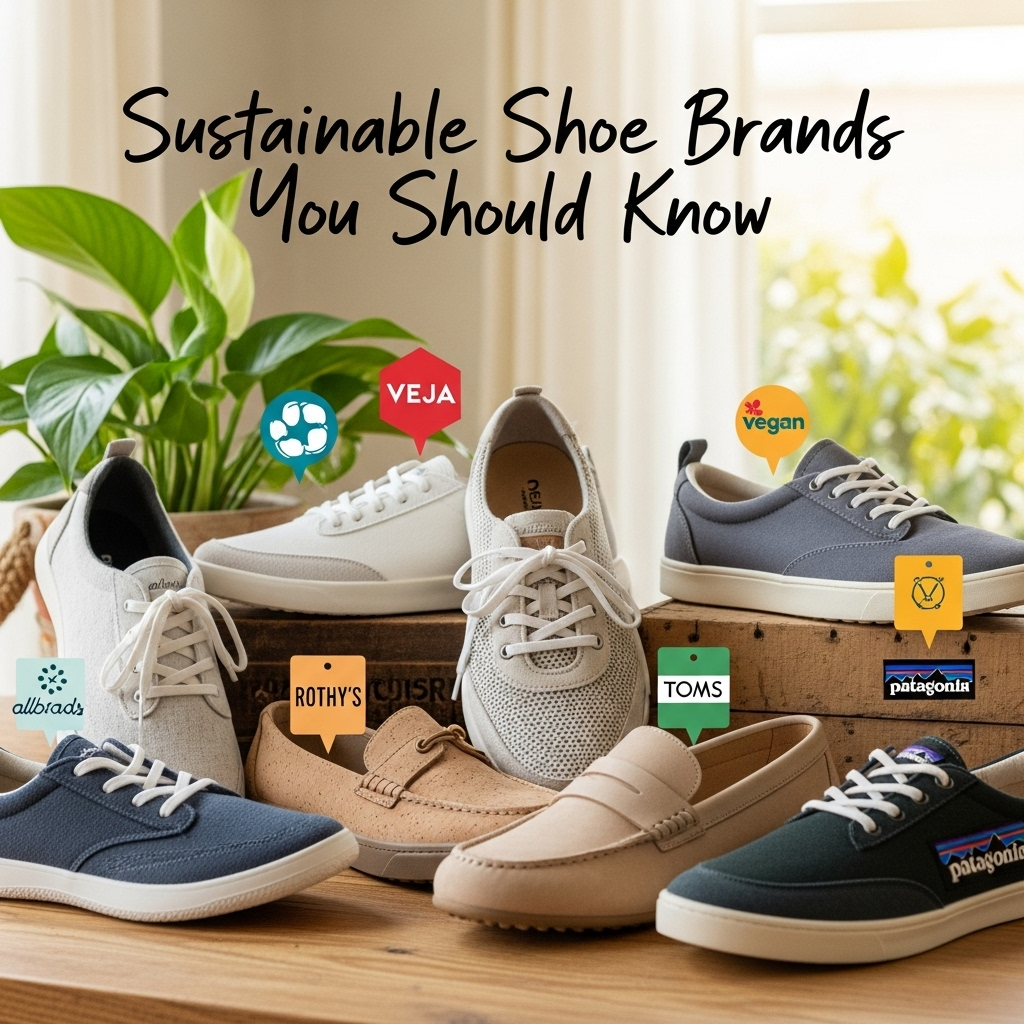The footwear industry is at a crossroads. With 90% of global footwear production relying on synthetic materials derived from fossil fuels and 1.4 billion pairs of shoes discarded annually in the U.S. alone, the environmental toll is undeniable. Yet a quiet revolution is underway: sustainable shoe brands are proving that eco-conscious design can coexist with cutting-edge style and performance. As a marketing director with 15 years in the footwear industry, I’ve witnessed this shift firsthand. What started as niche “green” experiments has exploded into a mainstream movement driven by consumer demand—73% of U.S. shoppers now prioritize sustainability when buying shoes, according to a 2025 StrutFit industry report.
This isn’t just about recycled materials; it’s a complete reimagining of how shoes are made, sold, and reused. Brands are innovating with algae-based foams, cactus leather, and closed-loop manufacturing while ensuring fair wages for workers. For U.S. consumers, this means more than ethical peace of mind—it’s access to durable, trend-forward footwear that aligns with values without sacrificing comfort. The best part? You no longer need to choose between conscience and couture. In this guide, we’ll cut through the greenwashing and spotlight verified sustainable shoe brands that deliver on both planet and performance.

What Really Makes a Shoe Sustainable?
Sustainability in footwear isn’t a single checkbox—it’s a holistic commitment across five critical pillars, as validated by StrutFit’s 2024 industry report. First, material innovation: brands must replace petroleum-based synthetics with certified bio-based or recycled alternatives (like ocean-bound plastic or apple peel leather). Second, ethical labor practices: fair wages, safe conditions, and gender equity throughout the supply chain—non-negotiables per The Good Trade’s methodology. Third, transparency: public disclosure of factories, carbon footprints, and material sources. Fourth, circularity: take-back programs, repair services, or biodegradable designs that prevent landfill waste. Finally, accountability: third-party certifications like B Corp, Fair Trade, or Climate Neutral.
“Sustainability is about more than a green product line. A truly sustainable brand looks at the totality of their business—from worker rights to end-of-life impact.”
— StrutFit Industry Report, 2024
Without all five pillars, a brand risks greenwashing—a top concern for 68% of U.S. shoppers. The Good Trade warns that vague terms like “eco-friendly” or “natural” often mask minimal change. Instead, look for specifics: “30% recycled ocean plastic” or “100% solar-powered factories.” Brands that publish annual impact reports (like Allbirds or Patagonia) earn trust by admitting gaps and setting measurable goals. For U.S. consumers, this rigor matters—Proposition 65 lawsuits in California have exposed misleading eco-claims, making verification essential.
Top 10 Verified Sustainable Shoe Brands for 2025
The Game-Changers: Premium Performance Meets Planet
| Brand | Key Innovation | Price Range | Best For | Certifications |
|---|---|---|---|---|
| Allbirds | Merino Wool, SweetFoam™ (sugarcane) | $95–$145 | Everyday sneakers | B Corp, Climate Neutral |
| Rothy’s | 3D-knitted recycled plastic bottles | $125–$175 | Flats & loafers | B Corp, Leaping Bunny |
| Veja | Wild rubber, organic cotton | $110–$160 | Classic sneakers | Fair Trade, B Corp |
| Nisolo | Leather from LWG-certified tanneries | $150–$250 | Boots & sandals | B Corp, 1% for the Planet |
Allbirds redefined comfort with its Tree Dasher 2, using eucalyptus fiber for breathable uppers and sugarcane-based foam that sequesters carbon. Their M0.0NSHOT line (launched 2024) cuts carbon emissions by 48% vs. conventional sneakers. Rothy’s turns 22 plastic bottles into each pair of Point Flats, with a 95% waste-free 3D-knitting process. Their Recycle Program melts worn shoes into new materials—proving circularity isn’t theoretical.
Pro Tip: Use the “4-Step Verification”
- Check labels: Look for Global Recycled Standard (GRS) or GOTS certifications.
- Scan the website: Legit brands have “Impact” or “Sustainability” tabs with data (e.g., carbon savings per pair).
- Beware “vegan leather”: Many are PVC-based—opt for Piñatex (pineapple) or Mylo (mushroom) instead.
- Demand repair kits: Brands like Nisolo include free resoling to extend shoe life by 5+ years.
The Ethical Essentials: Accessible & Impact-Driven
| Brand | Key Innovation | Price Range | Best For | Certifications |
|---|---|---|---|---|
| Cariuma | Bamboo, recycled cotton | $80–$120 | Casual sneakers | B Corp, 1% for the Planet |
| Toms | Repurposed plastic, hemp | $70–$100 | Slip-ons & sandals | B Corp, One for One |
| Olaplex | New! Algae-based foam (2025) | $115–$135 | Athletic sneakers | Climate Neutral |
| Saola | Coffee grounds, recycled rubber | $100–$140 | Trail runners | B Corp, Climate Neutral |
Cariuma’s Ipanema sneakers use 30% less water than conventional cotton and plant a tree for every pair sold. Their Recycle Program (with free shipping) refurbishes worn shoes for donation. Toms shifted from “one-for-one” giving to “Impact Grants” in 2023, funding community-led health initiatives in 70+ countries—proving ethical models evolve. For athletes, Olaplex’s 2025 Adaptive Runners use Algae Foam (grown using 90% less land than corn-based foams) while Saola’s Bamboo trail shoes incorporate coffee ground insoles for odor control.
“Finding the perfect sustainable shoes shouldn’t mean compromising on style, comfort, or sustainability. The search can feel overwhelming—but the right brands make it seamless.”
— Sustainably Kind Living, 2025
Breaking Down Greenwashing: 3 Red Flags to Avoid
1. Vague “Eco” Claims Without Proof
Phrases like “earth-friendly” or “made with care” signal minimal effort. Real brands specify:
- “Uppers made from 100% recycled PET (17 bottles per pair)” (Rothy’s)
- “Carbon footprint: 7.2 kg CO₂e per pair” (Allbirds)
- “Dye-free, waterless tanning process” (Nisolo)
2. Hidden Synthetics in “Natural” Shoes
A 2024 Verified Market Research study found 41% of “sustainable” shoes still use polyurethane (PU) soles—a plastic that sheds microplastics. Look for:
- Natural rubber (from FSC-certified forests)
- Recycled rubber (e.g., Saola’s 30% recycled content soles)
- Algae foam (Olaplex, Allbirds)
3. No Supply Chain Transparency
Ethical brands map their factories publicly. Veja lists 11 Brazilian rubber cooperatives and Peruvian cotton farms on their site. If a brand hides suppliers, skip it—74% of U.S. consumers say transparency is their top sustainability priority (The Good Trade, 2025).
The Future of Footwear: What’s Next in 2025–2026
Material Science Breakthroughs
- Mycelium Leather: Bolt Threads and Stella McCartney partner on Mylo™ for luxury shoes (launching at Reformation in Q1 2026).
- Carbon-Negative Foam: Lululemon’s 2025 BioBased Foam captures CO₂ during production—100% biodegradable in 5 years.
- Waste-to-Wear: Adidas and Parley now use fishing nets from The Ocean Cleanup for Ultraboost sneakers (2025 line).
Consumer Power Driving Change
U.S. shoppers are voting with wallets: sustainable footwear sales grew 32% in 2024 (vs. 5% industry average). Platforms like StrutFit now rate brands via “Sustainability Scores” based on real-time supply chain audits. As The Good Trade notes: “Through our purchases, we can make a positive difference for the people who make our shoes.”
Why U.S. Shoppers Should Care Now
The U.S. consumes 2.4 billion pairs of shoes annually—more per capita than any nation. But change is accelerating:
- California’s SB 62 law (2025) requires all footwear sold in-state to disclose environmental impact.
- Gen Z and Millennials (52% of U.S. shoe buyers) rank sustainability as their #1 purchase factor.
- Tax incentives for circular economy brands (e.g., repair credits) roll out in 2026.
Brands ignoring this shift face reputational risk. 73% of consumers would switch to a sustainable alternative if priced equally (Strut.fit, 2025). For marketing directors like me, the message is clear: sustainability isn’t a trend—it’s the new baseline.
How to Build a Conscious Shoe Wardrobe (Without Breaking the Bank)
Step 1: Audit Your Current Collection
- Keep: Shoes in good condition (repair if needed).
- Donate: Gently used pairs to Soles4Souls.
- Recycle: Worn-out shoes via Nike’s Reuse-A-Shoe or TerraCycle.
Step 2: Prioritize “High-Impact” Purchases
| Category | Why It Matters | Budget-Friendly Picks |
|---|---|---|
| Sneakers | Highest consumption (U.S. average: 7 pairs/year) | Cariuma, Veja |
| Work Boots | Long lifespan = lower lifetime impact | Nisolo, Blundstone (B Corp) |
| Summer Sandals | Often made with PVC; opt for natural materials | Saola, Glerups |
Step 3: Adopt a “Quality Over Quantity” Mindset
A single pair of Nisolo’s leather boots (made with LWG-certified tanneries) lasts 5+ years, replacing 3–4 fast-fashion pairs. Calculate cost-per-wear: at $200 for 1,500 wears, it’s 13¢ per wear vs. $50 fast-fashion boots at $0.33 per wear.
Your Action Plan: Shop Smarter Today
- Start with 1–2 investments: A versatile sneaker (e.g., Allbirds Tree Dasher) and a work shoe (e.g., Nisolo’s Elisa Boot).
- Join loyalty programs: Rothy’s and Cariuma offer 15% off for recycling old shoes.
- Demand change: Tag brands on social media with #ShowYourSupplyChain.
- Track progress: Use Good On You’s app to rate your shoe brands.
The data is clear: sustainable footwear isn’t a sacrifice—it’s a smarter choice for your wallet, health, and future. As Footwear Magazine declared in 2025, these brands are “proving that style and sustainability can go hand in hand.” For U.S. consumers, that means no more choosing between ethics and aesthetics. The revolution is already laced up—it’s time to step into it.
“From sneakers crafted out of recycled ocean plastics to luxury shoes made with plant-based leathers, these companies are proving that style and sustainability can go hand in hand.”
— FootwearMagazine.com
Ready to transform your footprint? Explore verified sustainable shoe brands at TheGoodTrade.com or SustainablyKindLiving.com. For deep-dive brand ratings, visit Strut.Fit.
